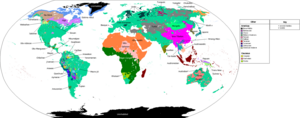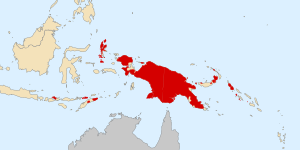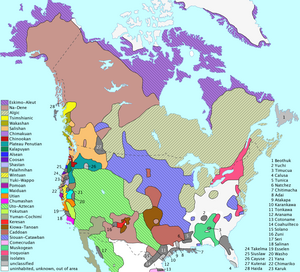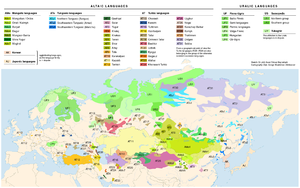Ethnologue: Languages of the World is an annual reference publication in print and online that provides statistics and other information on the living languages of the world. It is the world's most comprehensive catalogue of languages. It was first issued in 1951, and is now published by SIL International, an American evangelical Christian non-profit organization.

A language family is a group of languages related through descent from a common ancestral language or parental language, called the proto-language of that family. The term "family" reflects the tree model of language origination in historical linguistics, which makes use of a metaphor comparing languages to people in a biological family tree, or in a subsequent modification, to species in a phylogenetic tree of evolutionary taxonomy. Linguists therefore describe the daughter languages within a language family as being genetically related. The divergence of a proto-language into daughter languages typically occurs through geographical separation, with different regional dialects of the proto-language spoken by different speech communities undergoing different language changes and thus becoming distinct languages from each other.

The Nilo-Saharan languages are a proposed family of African languages spoken by somewhere around 70 million speakers, mainly in the upper parts of the Chari and Nile rivers, including historic Nubia, north of where the two tributaries of the Nile meet. The languages extend through 17 nations in the northern half of Africa: from Algeria to Benin in the west; from Libya to the Democratic Republic of the Congo in the centre; and from Egypt to Tanzania in the east.
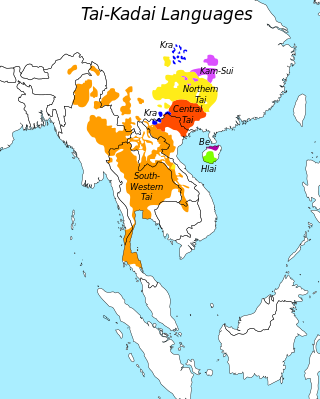
The Kra–Dai languages, are a language family in mainland Southeast Asia, southern China, and northeastern India. All languages in the family are tonal, including Thai and Lao, the national languages of Thailand and Laos, respectively. Around 93 million people speak Kra–Dai languages; 60% of those speak Thai. Ethnologue lists 95 languages in the family, with 62 of these being in the Tai branch.
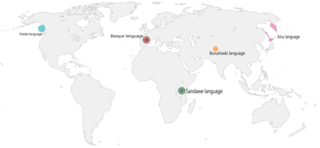
A language isolate is a language that has no demonstrable genetic relationship with another language. Basque in Europe, Ainu in Asia, Sandawe in Africa, Haida and Zuni in North America, Kanoê in South America, and Tiwi in Australia are all examples of language isolates. The exact number of language isolates is yet unknown due to insufficient data on several languages.
The Nubian languages are a group of related languages spoken by the Nubians. In the past, Nubian languages were spoken throughout much of Sudan, but as a result of Arabization they are today mostly limited to the Nile Valley between Aswan and Al Dabbah. In the 1956 Census of Sudan there were 167,831 speakers of Nubian languages. Nubian is not to be confused with the various Nuba languages spoken in villages in the Nuba mountains and Darfur.
An unclassified language is a language whose genetic affiliation to other languages has not been established. Languages can be unclassified for a variety of reasons, mostly due to a lack of reliable data but sometimes due to the confounding influence of language contact, if different layers of its vocabulary or morphology point in different directions and it is not clear which represents the ancestral form of the language. Some poorly known extinct languages, such as Gutian and Cacán, are simply unclassifiable, and it is unlikely the situation will ever change.

This is a list of different language classification proposals developed for the Indigenous languages of the Americas. The article is divided into North, Central, and South America sections; however, the classifications do not correspond to these divisions.
Yuracaré is an endangered language isolate of central Bolivia in Cochabamba and Beni departments spoken by the Yuracaré people.
Salvadoran Sign language is a language used by the deaf community in El Salvador. Its main purpose is to communicate. There are three distinct forms of sign language. American Sign Language was brought over to El Salvador from the United States by missionaries who set up small communal schools for the deaf. The government has also created a school for the deaf, teaching by means of their own modified Salvadoran Sign Language. The third type of sign language used is a combination of American Sign Language and Salvadoran Sign language. Most deaf understand and rely upon both. Their own unique Salvadoran Sign language is based on their language and is most useful in regular encounters; however, American Sign Language is often relied on within education due to the larger and more specific vocabulary. This is the reason that the deaf community within El Salvador sometimes relies upon both ASL and SSL in a combined form.
The Sere languages are a proposed family of Ubangian languages spoken in South Sudan and the Democratic Republic of the Congo. Several are endangered or extinct. The most populous Sere language is Ndogo of South Sudan, with about 30,000 speakers.
The Sal languages, also known as the Brahmaputran languages, are a branch of Tibeto-Burman languages spoken in northeast India, as well as parts of Bangladesh, Myanmar (Burma), and China.
The French Sign Language or Francosign family is a language family of sign languages which includes French Sign Language and American Sign Language.
Armenian Sign Language is the deaf sign language of Armenia.
Saudi Sign Language is the deaf sign language of Saudi Arabia. This sign language is different from the Unified Arabic Sign Language that is used by 18 Arab countries. There are 100,000 deaf people in Saudi Arabia.
Sri Lankan Sign Language is a visual language used by deaf people in Sri Lanka and has regional variations stemming from the 25 Deaf schools in Sri Lanka.
The Swedish Sign Language family is a language family of sign languages, including Swedish Sign Language, Portuguese Sign Language, and Finnish Sign Language.
Massep is a poorly documented Papuan language spoken by fewer than 50 people in the single village of Masep in West Pantai District, Sarmi Regency, Papua. Despite the small number of speakers, however, language use is vigorous. It is surrounded by the Kwerba languages Airoran and Samarokena.
Duli is an extinct Adamawa language of northern Cameroon.
The Danish Sign Language family comprises three languages: Danish Sign Language, Norwegian Sign Language and Icelandic Sign Language. It itself is a sub-language family within the larger French Sign Language family.
